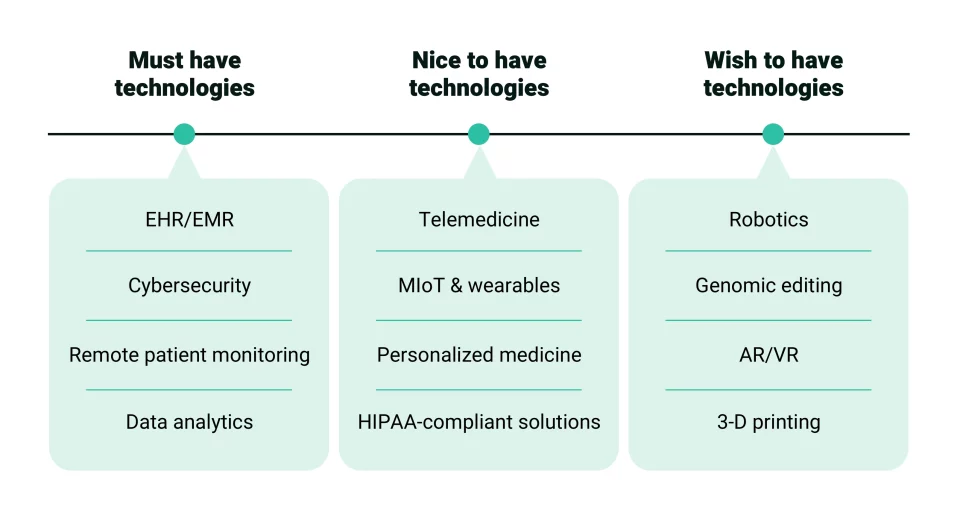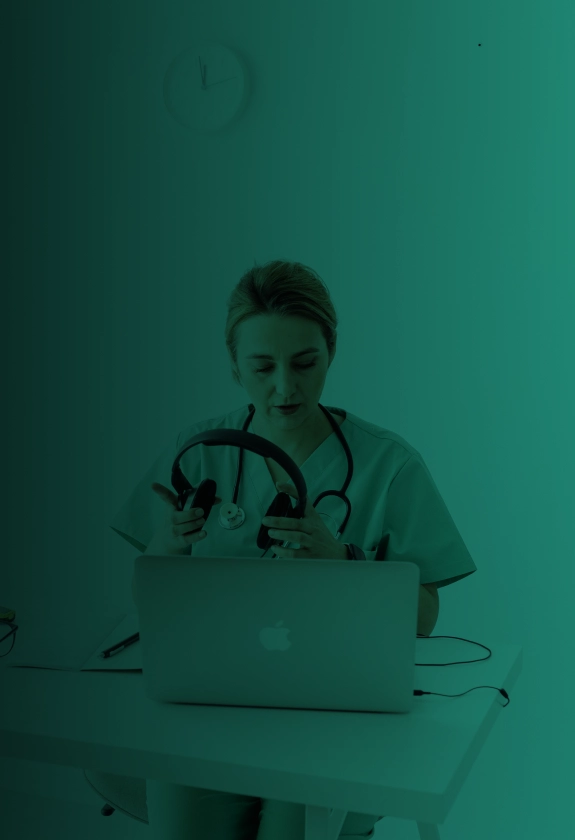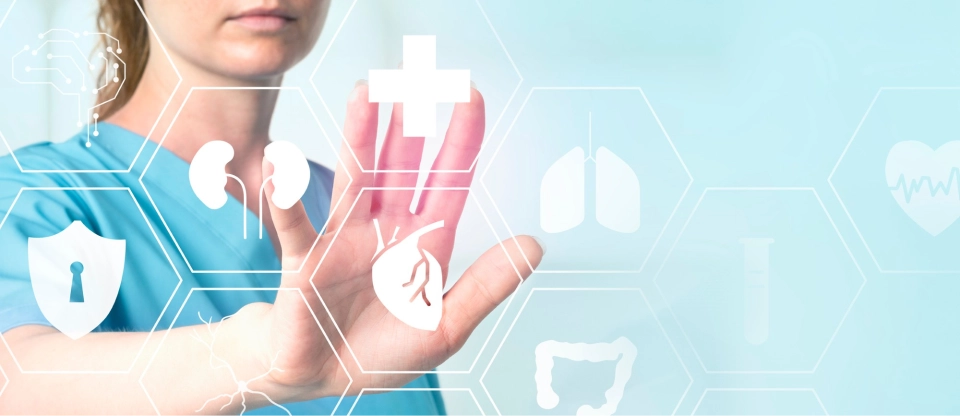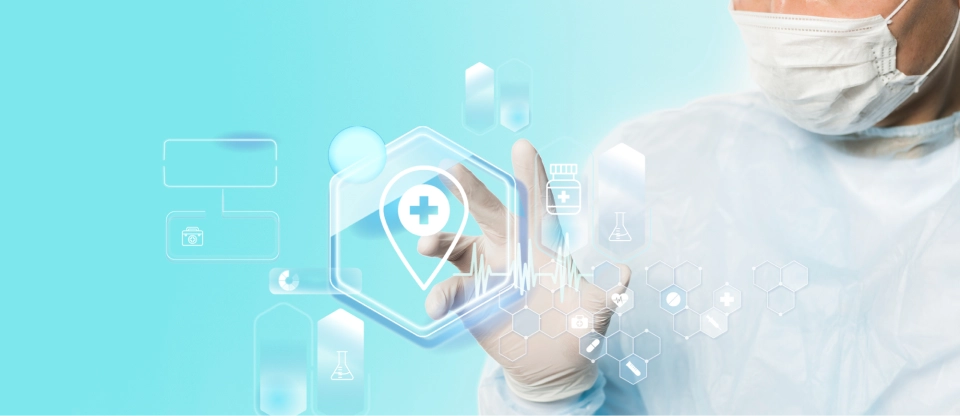INTRODUCTION
Technology-led healthcare is the way ahead
The rapid pace of technological advancements has seen the healthcare industry undergo a remarkable transformation. The manner in which clinicians diagnose, treat, and manage patients has improved drastically in recent years - so much so that healthcare enterprises, professionals, and even patients have no choice but to update themselves on technology trends in healthcare.
Precision medicine, data-driven decision-making, and custom telemedicine will help professionals make a name as healers; for organizations that embrace these advancements, the rewards are improved patient care, increased cost-efficiency, and enhanced accessibility of healthcare services. As for patients, new healthcare IT trends enable earlier disease detection, personalized treatment plans, and remote monitoring.
This blog will throw light on the key technology trends in healthcare that are shaping the industry in 2023 and beyond. Healthcare deliveries and outcomes are poised for a significant transformation as emerging health tech trends are used to:
- Streamline processes and reduce errors.
- Increase accessibility to remote and under-served areas.
- Gather real-time data for patient-centric treatment pathways.
TRENDS
Top digital transformation trends in healthcare
There is such an explosion of hospital digital transformation trends and innovations around healthcare software trends that it may be difficult to list them all. Here is a ready reckoner with a market outlook for some cutting-edge solutions that feature in most listings of top healthcare IT trends:
Artificial intelligence (AI) and machine learning (ML)
AI- ML solutions are leveraged to collect and interpret large sets of data, which are processed with predictive analytics. With image recognition combined, it is possible to accelerate diagnosis and improve patient care.
Market outlook: The AI healthcare market, valued at $11 billion in 2021, is projected to be worth $187 billion in 2030 – Statista.
Telemedicine and remote monitoring
Access to seriously ill patients remotely through telemedicine helps to manage short-term illness, chronic conditions, health emergencies and pregnancies.
Market outlook: The global telemedicine market size was valued at $87.41 billion in 2022 & is projected to grow from $94.44 billion in 2023 to $286.22 billion by 2030. – Fortune Business Insights
Blockchain for healthcare data security
Blockchain technology supports a unique pattern of data storage and the highest level of security. So, it helps to ensure patient data privacy and interoperability.
Market outlook: The market size for blockchain technology in healthcare was valued at $3.27 billion in 2023 and is expected to touch $126.02 billion in 2030. – Grandview Research
Precision medicine
Whole genome and targeted sequencing have introduced genomic and molecular biological testing methods for diagnostics and therapeutics. This helps to provide personalized medicines to patients and improve outcomes.
Market outlook: The global precision medicine market valued at $50 billion in 2020, is anticipated to grow at a CAGR of 11.9% to clock $95.5 billion by 2030. – Vision Research Reports
Medical IoT (Medical Internet of Things) in healthcare
The insights generated from data collected through sensors in wearable devices used by patients help to make treatment plans effective. It also helps to reduce the strain on healthcare delivery systems.
Market outlook: The global MIoT in the healthcare market was valued at $ 217.34 billion in 2022 and is forecast to grow to $ 960.2 billion by 2030 at a CAGR of 20.41% – Precedence Research
Robotics and automation
Robot-assisted surgeries will increase precision and reduce risks, thereby augmenting patient care and medication inventory system management.
Market outlook: The global medical robotics market valued at $11.67 billion is predicted to touch $52.41 billion in 2030. – Market Research Future
3D printing in medical applications
3D printing is used to create customized equipment, devices, implants, and prosthetics and for bone and joint reconstruction.
Market outlook: The market size of 3D printing in healthcare was valued at $1,036.58 million in 2020 and is projected to reach $5,846.74 million by 2030. – Allied Market Research
Augmented reality (AR) and virtual reality (VR)
AR and VR technologies are used to augment patient comfort, relieve pain, induce sleep, and also for applications in medical training.
Market outlook: The global market for AR and VR in terms of revenue growth is expected to touch $14.06 billion in 2030, growing at a CAGR of 12.5 % from $2 billion in 2020.
Genomic editing
CRISPR/CAS9 and other genomic editing tools are being employed to try out gene therapies that have the potential to cure genetic diseases.
Market outlook: The global genome editing market size is expected to grow from $5.06 billion in 2021 to $21.36 billion by 2030 at a CAGR of 17.33. – Strategic Market Research
Healthcare data analytics
Advanced analytics tools are being deployed by healthcare organizations to help make data-driven decisions that optimize operations and improve patient outcomes.
Market outlook: The global healthcare data analytics market is projected to grow at a CAGR of 23.12% from $26.70 billion in 2023 to reach $122.20 billion in 2030 – Verified Market Research
The integration of the above technology trends in healthcare is bound to improve patient care, cost-efficiency, and accessibility.
 There is an explosion in healthcare technologies
There is an explosion in healthcare technologies
DETAILS
Impact, relevance, challenges and benefits of tech trends
Let us now take a close look at the relevance of the top technology trends in healthcare for 2023 and understand the impact and implications of each trend. It is good to peep into the challenges posed as well.
Artificial intelligence for diagnosis and treatment
While it is true AI algorithms analyze vast amounts of data, aiding accurate diagnosis –far surpassing human capabilities - there are concerns about data privacy and ethical use.
Benefit: Precise diagnosis leads to personalized treatment plans and improved patient outcomes.
"AI can reduce hospital costs by 30% and patient mortality rates by 40%."
- Frost & Sullivan
Remote patient monitoring (RPM) for equitable healthcare
RPM enables continuous watch and is of value for high-risk patients but is challenged by licensure issues and data privacy.
Benefit: Patients can avail of treatment at home while healthcare facilities optimize costs.
"A combination of remote monitoring, telehealth, social supports, and home modification may enable more patients to receive some level of care at home."
- McKinsey & Company
Blockchain for secure health records
While blockchain technology streamlines the sharing of EHRs, standardization and data governance are key concerns.
Benefit: It enhances interoperability and data security while reducing data breaches.
"The proprietary electronic health record (EHR) systems made by more than 700 vendors routinely don’t talk to one another. Blockchain is by nature a team sport which encourages deep collaboration."
- IBM
Personalized medicine and genomics
With genomics, treatment plans tailored to a person’s genetic profile are possible, but ethical issues hinder its progress.
Benefit: Optimized drug selection, reduced adverse reactions, and improved patient outcomes through personalized treatment.
"Everyone has their own unique genomic blueprint and molecular makeup and this approach will help us to match better the therapy we prescribe to the disorder the individual has."
– PwC
IoT and wearable health devices:
Preventive care is getting importance with health data streaming in through remote monitoring. However, the integration of IoT data into clinical workflows is a challenge.
Benefits: Early detection of health issues, improved patient engagement, and reduced hospital admissions.
"The global market for wearable technology will reach $161 billion by 2033. This represents a CAGR of 6% compared with 2023."
- IDTechEx
Electronic health records (EHR) and interoperability
EHR interoperability ensures the seamless exchange of data, modernizing healthcare, but data security, regulatory compliance, and standardization are challenges.
Benefit: Improved patient data accessibility and interoperability can help reduce errors.
"Improved operational efficiencies, cost reduction, and improved outcomes will boost the EHR market growth, and it will touch $42.32 billion by 2027."
- Mordor Intelligence
VR/AR in healthcare training
VR and AR technologies are used for medical training and surgical planning, but the costs can be prohibitive and the setup is also complex.
Benefit: Improved training and interactive patient engagement.
"Orthopedic surgeons trained using VR were 230% more efficient in performing surgical procedures than their peers who received traditional training - Harvard Business Review."
Robotics and automation in healthcare
Robotic surgeries may be less invasive but are expensive and require greater compliance with quality and safety regulations.
Benefit: Robots enhance surgical precision, reducing post-surgery infections and hospital stays, while automation improves operational efficiency.
"In a 12-country survey, 54% of the respondents said they were willing to substitute robotics and AI for humans to cater to their healthcare needs."
- PwC
Cybersecurity in healthcare
Safeguarding sensitive patient data is vital for healthcare organizations as security breaches erode patient trust, interrupt services, and violate regulations.
Benefit: Robust cybersecurity measures in healthcare ensure patient privacy, operational continuity, and enterprise reputation.
"The average cost of a data breach in healthcare is $9.23 million per incident."
- IBM
Network strategies in healthcare
Superior design, implementation, and management of data networks for healthcare enable seamless communication, though interoperability poses challenges.
Benefit: It helps in the secure exchange of data, running of data-intensive apps, and high-speed connectivity for telemedicine and remote care.
"By leveraging a zero trust approach along with network segmentation, automation techniques, and access control, healthcare organizations can create a secure, agile, and resilient infrastructure that protects patient data, ensures compliance with regulations, and improves patient outcomes."
- Cisco
CONCLUSION
Keep pace with technology trends for quality care
These technology trends in healthcare have the power to transform the healthcare industry. Healthcare enterprises and providers can bring in positive change if they embrace emerging trends in healthcare technology to ensure:
Enhanced patient care: Healthcare software trends promise accurate diagnoses, personalized treatments, and improved patient outcomes.
Cost-Efficiency: Healthcare IT trends have streamlined processes and reduced errors, while telehealth has reduced healthcare costs.
Health equity: Telemedicine and remote monitoring and future trends in healthcare technology promise healthcare equity, ensuring all patients receive timely care, regardless of location and socio-economic factors.
Data security and compliance: Prioritizing cybersecurity and interoperability ensures patient data protection and regulatory compliance. Providers are better advised to watch healthcare digital transformation trends and stay updated to avoid cyber-attacks.
Adapting to 2023 technology trends in healthcare is clearly a must for healthcare professionals and enterprises that wish to provide the highest quality of care. Keeping tabs on future trends in healthcare technology is, in fact, a commitment to the well-being and satisfaction of patients and the long-term success of the healthcare industry.






